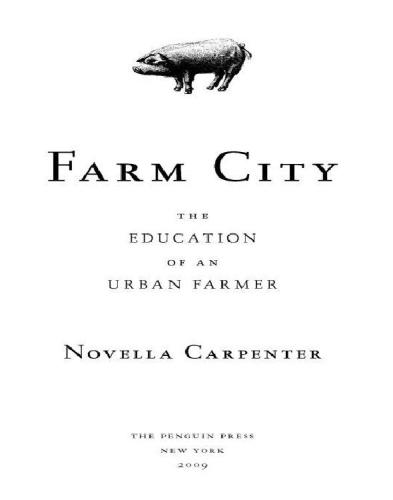
Farm City
The Education of an Urban Farmer
کتاب های مرتبط
- اطلاعات
- نقد و بررسی
- دیدگاه کاربران
نقد و بررسی

Starred review from April 20, 2009
In this utterly enchanting book, food writer Carpenter chronicles with grace and generosity her experiences as an “urban farmer.” With her boyfriend Bill’s help, her squatter’s vegetable garden in one of the worst parts of the Bay Area evolved into further adventures in bee and poultry keeping in the desire for such staples as home-harvested honey, eggs and home-raised meat. The built-in difficulties also required dealing with the expected noise and mess as well as interference both human and animal. When one turkey survived to see, so to speak, its way to the Thanksgiving table, the success spurred Carpenter to rabbitry and a monthlong plan to eat from her own garden. Consistently drawing on her Idaho ranch roots and determined even in the face of bodily danger, her ambitions led to ownership and care of a brace of pigs straight out of E.B. White. She chronicles the animals’ slaughter with grace and sensitivity, their cooking and consumption with a gastronome’s passion, and elegantly folds in riches like urban farming history. Her way with narrative and details, like the oddly poetic names of chicken and watermelon breeds, gives her memoir an Annie Dillard lyricism, but it’s the juxtaposition of the farming life with inner-city grit that elevates it to the realm of the magical.

Starred review from May 1, 2009
Urban eccentricity meets rural thrift and tradition in a charming debut memoir about the author's farm in downtown Oakland.
Carpenter, the progeny of two hippies whose attempt to go"back to the land" ended in near disaster, was drawn to farming yet unwilling to give up the cultural and intellectual perks of an urban environment: museums, bars, libraries, etc. Already an amateur apiarist and avid gardener, she moved with her husband from the Seattle suburbs to"Ghost Town" Oakland, attracted by its energy and diversity, undeterred by the nightly drive-bys. Of equal interest to the author was the garbage-filled abandoned lot next door. Soon, her visions of heirloom tomatoes, peach trees, fresh squash, even watermelons, became a reality. Inspired, she added a few chickens, then some ducks, geese, two turkeys, a few rabbits and two pigs. Carpenter found herself increasingly enveloped in the beautiful yet brutal circle of life that rules a farm. She gives heart-rending descriptions of her emotions when stray dogs killed one of the turkeys, but also admits that she intended to harvest the remaining bird for Thanksgiving dinner. In warm, witty prose, she describes feeding her livestock with scraps foraged from neighboring restaurants, as well as visits from local children, Vietnamese monks and eccentric neighbors, many of whom joined the author for meals and enjoyed the fruits of her labors. The special relationship between farmer and food was driven home for Carpenter when a local chef taught her traditional rural Italian techniques for harvesting every part of her pigs to create delicacies from headcheese and pork broth to prosciutto and salami. Experiencing Carpenter's trials and tribulations, readers will get an honest portrait of where meals come from and an understanding that connecting with the food chain, even in the smallest ways, can enrich the palate and the soul.
A fascinating, vividly written story about city and community that will change perceptions about the local farmers market.
(COPYRIGHT (2009) KIRKUS REVIEWS/NIELSEN BUSINESS MEDIA, INC. ALL RIGHTS RESERVED.)

June 1, 2009
When Carpenter and her boyfriend rented a duplex apartment in an inner-city Oakland neighborhood, the main attraction for them was the overgrown vacant lot next door. Carpenter started "squat gardening" and progressed from growing vegetables and keeping bees to raising poultry, rabbits, and pigs. In this memoir, she writes about how she managed to feed all this livestock, how she turned her animals into meals, and how her neighbors reacted to her unorthodox activities. Carpenter describes beheading a duck in her bathtub and breaking a rabbit's neck with the back of a rake. When an opossum wanted a meal and killed two of her birds, she beat it to death with a shovel. Relating a neighbor's complaint about the awful smells, Carpenter writes, "The ammonia smell from the rabbit pee festered in the sun and blended with six months' worth of pig shit to cause a reeking smell." VERDICT Urban gardens can be an asset to communities, but this picture of urban farming, apparently meant to be offbeat and amusing, has little humor, charm, or food for thought. Readers would do better with Michael Abelman's "On Good Land: The Autobiography of an Urban Farm".Ilse Heidmann, Washington State Lib., Olympia
Copyright 2009 Library Journal, LLC Used with permission.

May 15, 2009
Having moved into one of Oaklands most blighted neighborhoods, Carpenter takes up cultivating a neglected plot of urban earth behind her apartment. Not only does she raise lettuces, she maintains beehives and nurtures chickens, turkeys, and even rabbits. Her neighbors, a delightfully odd lot of immigrants, Buddhist monks, vegans, and gang members, have decidedly diverse reactions to farm animals in their midst. Carpenter experiences the plagues and reversals common to farmers everywhere: dead queen bees, poachers, murderous dogs, and assorted natural blights. Add to that the quotidian tribulations of the inner city: druggies, muggers, and car thieves. Throughout all this, Carpenters good humor never entirely flags, even when Thanksgiving and its requisite slaughter approaches. Carpenters bonding with her plants and animals evokes many an emotional moment, but she never succumbs to maudlin sentimentality. Her transparent prose mirrors her urban farm: chockablock, nontraditional, and unkempt, yet intelligently real and utterly engrossing.(Reprinted with permission of Booklist, copyright 2009, American Library Association.)

























دیدگاه کاربران